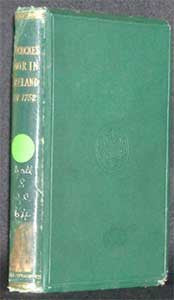Cat No.: IET0062:
Born in Southampton in 1704 (d. 1765), Dr Richard Pococke, later bishop of Ossory (1756-65) and Meath (1765), is best known for his travel writings and diaries. Pococke had a passion for travelling, and travelled extensively through Ireland and Britain and further abroad. During the 1750s Pococke undertook a number of tours around various parts of Ireland, the longest of which occurred during the summer and autumn of 1752. In the course of that tour Pococke travelled in a circuit around Ireland, passing through twenty counties, and recording the details of his expedition. His diary of this remarkable tour remained in the library of Trinity College for almost a century and a half, until it was first published, edited by George Stokes, the noted antiquarian, in 1891.
Pococke's tour is a very important source for anybody interested in Irish society in the eighteenth century for two reasons. In the first instance, it is extremely detailed, providing a balanced account of his experiences during his extraordinary tour. Secondly, it provides descriptive accounts of parts of the country which rarely appear in eighteenth-century accounts, including remote parts of west Donegal and west Mayo.
Setting off from Dublin on 22 June, Pococke first travelled north, through Drogheda and County Down to Belfast. Belfast, which by the latter decades of the nineteenth century, had emerged as an economic rival to Dublin, consisted in 1752 of 'one long broad Street, and of several lanes in which the inferior people live' (p. 21). From Belfast, he travelled northwards to the Giant's Causeway, and then westwards, through Coleraine to Derry city. From Derry, he travelled to Letterkenny, via Inishowen, where his description of contemporary housing is notable - 'the houses are built with sods, supported within by a wooden frame, which the poor people sometimes leave with their effects, when the collector of the hearth money approaches' (p. 55). From Letterkenny, he travelled southwards, through Sligo and Mayo, arriving at Galway on 14 August, more than seven weeks into his tour.
Having rested at Galway for a few days, he travelled through Clare to Limerick, and on to Cork city, pleasantly situated, but with 'narrow and dirty' streets (p. 118). Readers may be confused by the details of the next stage of his journey, from Cork to Kilkenny, as he notes that he departed Cork on 4 September, and arrived at Cashel and Killenaule on 2 September, and onwards to Kilkenny. This confusing dating is not a mistake on Pococke's part, because in September 1752 Ireland and Britain adopted the new-style calendar, which involved an eleven-day shift in the calendar (p. 127). Thus, readers may observe that Pococke did not record the actual dates for his trip between Lismore and Villierstown, which coincided with the change in the calendar. In Waterford city by 15 September (new style), he travelled westwards through the county, via Ardmore and Dungarvan, to return again to the city.
He departed Waterford on 2 October, on the final leg of his journey. He travelled through south Wexford, through Bargy and Forth, with its distinctive dialect (p. 154), and on to Wexford town, with its narrow streets (p. 155). Departing Wexford on 6 October, he travelled northwards, through Arklow and Bray, arriving back in Dublin on 11 October, after 100 days travelling.
Researchers with an interest in travel writing and social history will find this an extremely readable and useful account of eighteenth-century Ireland.
No. of CDs is: 1 ; Format is: PDF ; Searchable?: YES;
FastFind: No; ISBN No.: unavailable;


